I’ve been asked frequently over the years to create Zen gardens for clients. After drawing spaces laden with stone lanterns and Buddha heads, then being told, “No, that’s not quite right for me,” I began to rethink things. Eventually it occurred to me that what these people were after was not a Japanese garden at all, but rather a space that gave them the
feeling of a Japanese garden. They simply didn’t know how to articulate their desire.
The truth is that the culture and symbolism of the Japanese Zen garden doesn’t always translate well to our minds and spaces. But by understanding placement and materials, as well as the Japanese aesthetic of
wabi-sabi (finding beauty in the imperfect, transient, incomplete and humble), you can create the Zen garden of your dreams. Let’s see how.
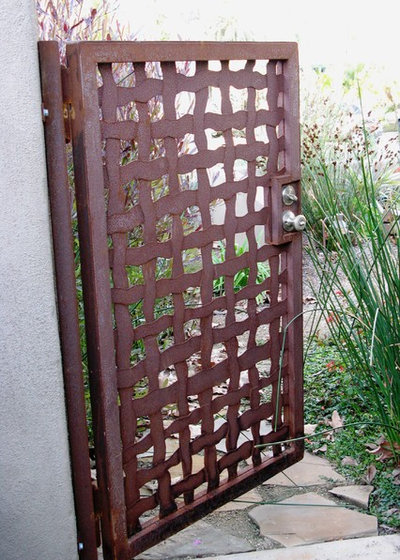
debora carl landscape design
The garden gate. The best place to start is at the beginning, at the entrance to your garden. Most Zen gardens are enclosed and need a defined point of entry. A gate in a Zen garden is both practical and symbolic. Practically speaking, a gate provides accessibility to the space and keeps unwanted creatures out. Symbolically, it lets visitors know they are entering a defined space, and that they can leave the stresses of everyday life at the door.
The rusted metal gate shown here pays homage to the timeworn, imperfect look of
wabi-sabi, but its orderly grid gives it wide appeal.
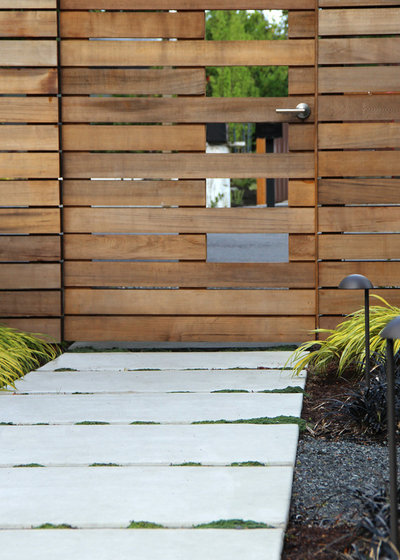
Bliss Garden Design
The enclosing fence. A room, by definition, has walls. An outdoor room should have the same, whether the walls are built from hardscape materials or from a living hedge. A fence creates anticipation of what’s on the other side. The gaps in the fence seen here feed this sense of anticipation because they thoughtfully expose chosen parts of the enclosed space. Furthermore, this fence mimics the horizontal pattern in the pathway, establishing a rhythm and creating continuity between materials.
Consider the style, material and run of your fence. A wood fence, while requiring some maintenance, feels more organic and solid than most metal fences. A horizontal run will provide the garden visitor with a warm, soothing feeling of being enclosed, not unlike a hug, and will keep the eye moving around the space. A vertical run will cause the viewer to look upward, which might be preferable if your space includes a spectacular tree canopy, but it won’t give the same soothing feeling that a horizontal fence provides. Other options include metal or polycarbonate panels. The latter might give the feeling of a shoji screen, an appropriate style for this genre of garden.
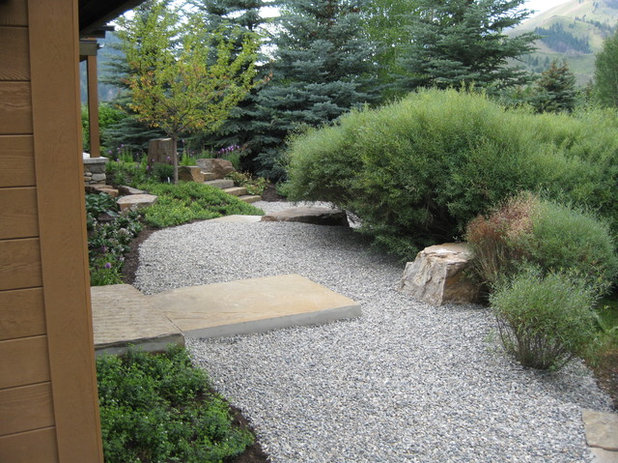
Ben Young Landscape Design
The path. Pathways are essential to any garden, particularly the Zen garden. Every garden needs to be easily navigable, but paths in a Zen space should take on added meaning. They do the navigating for the visitor so that he or she is free to peacefully and fully concentrate on the garden’s essence.
The shape of the path is also key. Straight paths generally accelerate the speed at which visitors move through a space. Curved paths slow the visit down while building anticipation of what lies around the bend. The
yatsuhashi, or zigzag path, provides a contemplative, peaceful vibe, similar to a labyrinth. A purposefully placed branch that leans over a pathway just enough to brush against visitors may slow them down further or redirect their attention. The Zen garden is a bit of a contradiction: Nothing is left to chance, yet a well-designed space appears to embrace serendipity.
The path’s width is also an important consideration. Paths are traditionally built 4 feet wide to allow two average-sized adults to walk side by side. Designing a narrower secondary path, perhaps only 2 feet wide, slows visitors down and forces them to move in single file through the space, creating a unique experience for each person. The philosophical meaning here is profound: Even though we are surrounded by people in our daily lives, our life journey is truly our own.
A path doesn’t have to be the same width from beginning to end. Narrowing the path near certain key focal points will cause the visitor to stop, notice and contemplate. It’s essential to provide a smooth transition between widths, however, both to continue the flow and for safety.
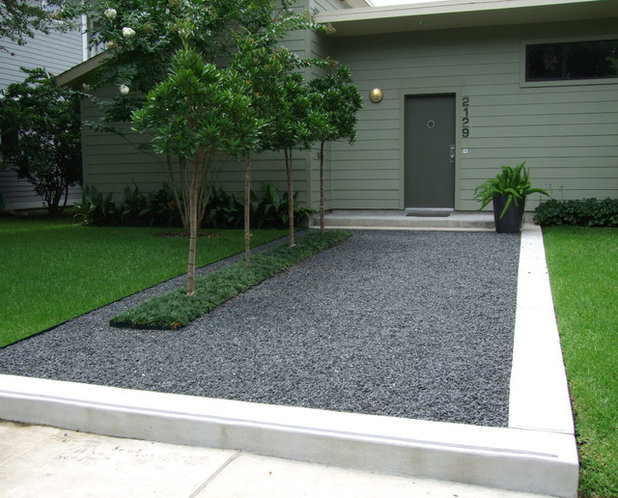
McDugald-Steele
Gravel. A good material to consider for your paths is gravel. It’s inexpensive, organic, easily installed and available in a wide range of colors. It’s also textural, providing another layer of experience through its auditory crunch when walked upon. From a philosophical point of view, footprints leave an impression, showing that someone has been there and has made a lasting connection with the garden.
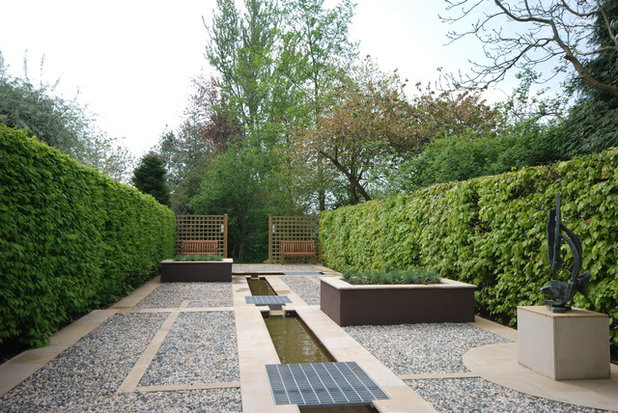
Lizzie Tulip Garden Design
Simple lines. Simplicity is both a muse and a goal in the Zen garden. Notice how the design of this garden is architecturally complex, yet the space still reads as simple and homogenous. The lines are similar and generally at 90-degree angles. Whether these lines are introduced with the stone pavers, the bar grates, the raised planters or the clipped hedge, they relate unobtrusively to one another and create a peaceful dialogue.
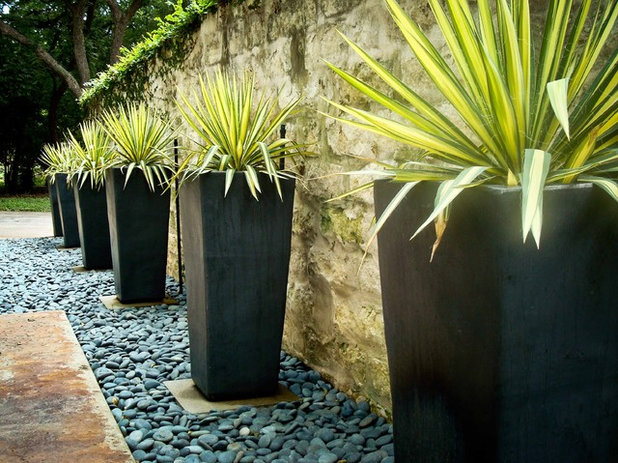
BLUE Renovation & Landscape
Rhythm through repetition. Thoughtful repetition is at the heart of the Zen garden. Instead of having a mismatched one of this and one of that, repetition does the mental processing for you, so all you have to do is sit back and peacefully assimilate.
Rhythm is soothing because it’s how we feel a connection with a space. We all have internal rhythms, whether it’s our pulse or that song that plays nonstop in our heads. Rhythm through thoughtful repetition in the garden speaks to our internal rhythms. The ensuing conversation produces tranquillity.
Teach Your Landscape Rhythm
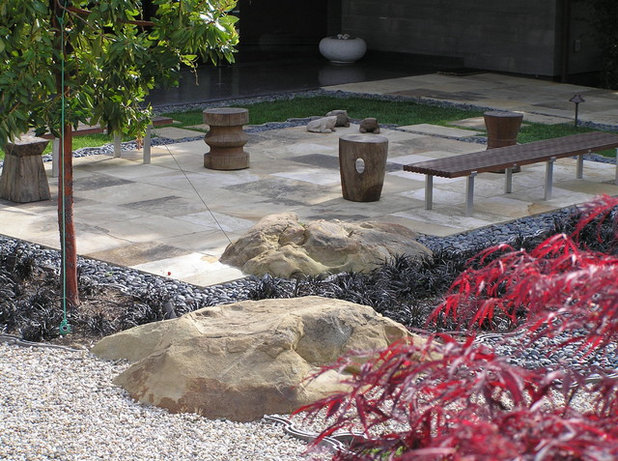
Charles McClure - Professional Site Planning
Boulders. Many people would consider boulders essential to the Zen garden. Their textural, timeworn look lends a mood of antiquity to even the most contemporary space. Boulders add interest and juxtaposition to a venue. Notice how the boulders in this photo cut into a flat patio of rectangular stone pavers. They create a third dimension, one that’s repeated with the patio furniture, while making a meaningful connection to the pavers through color and material.
Before placing your boulders, you might find it helpful to take a day trip to the mountains or a river. There you’ll see that very rarely do boulders sit atop the ground, strewn about indiscriminately. Instead, they’re generally sunken into the earth. It’s good to bury ⅓ to ½ of your boulder for a more natural look. Also consider shape and color. It may be preferable to choose boulders that are indigenous to your area and in a color that complements your other hardscape.
Give thought to the size of the boulders. A common mistake is to choose ones of inappropriate scale, particularly since larger boulders are difficult to move into place. You’ll be happier in the long run if you employ a professional installer or rent heavy equipment to properly site your boulders.
How many is too many? I’ve seen landscapes that more closely resemble stone quarries than gardens. It may be helpful to think in terms of creating vignettes, with a boulder being a focal point, then linking the vignettes together with a planting sequence. Finally, consider that odd numbers read as more natural than even numbers, so one or three boulders may be more attractive than two or four.
For Garden Drama, Consider the Lowly Boulder
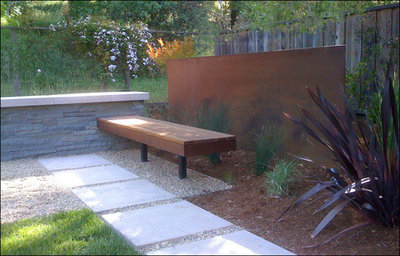
Huettl Landscape Architecture
Seating. Seating in a Zen garden should be simple and unadorned and should make a meaningful connection with its surroundings through color, shape and texture. Even though Chinese red (a red-orange) is common in Asian Zen gardens, your modern chartreuse bench may be best sited in another area of your garden.
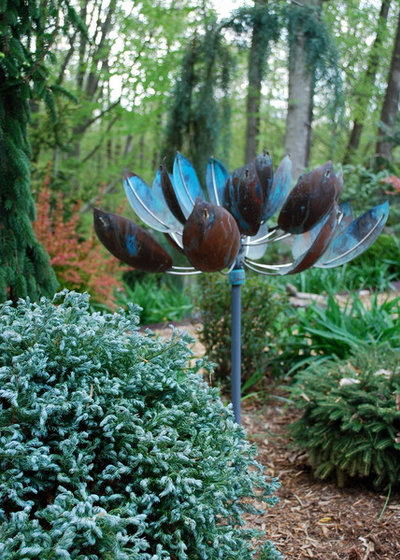
Jay Sifford Garden Design
Simple, thoughtful art. I firmly believe that every well-designed garden should contain at least one piece of quality art. In the contemporary Zen garden, simpler is better. Avoid vivid hues and complex shapes — the tranquil spirit of your garden is at stake. Instead, choose simple pieces with organic shapes and colors that create a dialogue with other garden features. This simple wind sculpture by Lyman Whitaker has the organic shape of a lotus flower while repeating the essential hues of surrounding plants. It moves in the breeze, bringing another layer of interest to the venue.
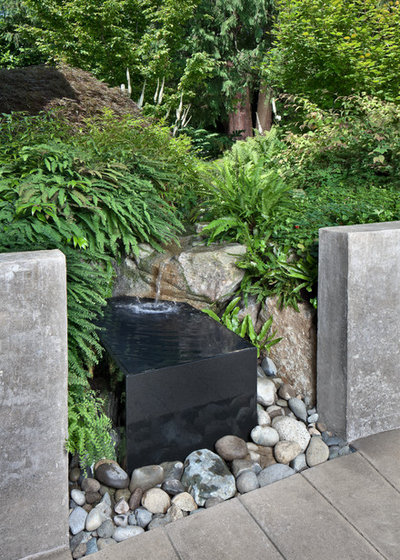
Broadhurst + Associates
Water. Nothing adds a sense of peace to a space like water. It brings sound, movement and reflection to a garden. Asian Zen gardens almost always include an element of water, whether it’s a small bamboo deer chaser with stone basin or a large pond with waterfall.
When choosing a water feature for your Zen garden, think simple, natural and understated. If possible, steer away from the pre-plumbed ceramic pot kits readily available at the local garden center. Instead, choose something unique that forges a bond with the landscape. After all, Zen embodies peaceful continuity.
The polished stone cube shown here is a contemporary take on the boulder by which it sits. Its shape also creates a dialogue with the adjoining poured concrete walls. Its simplicity is memorable.
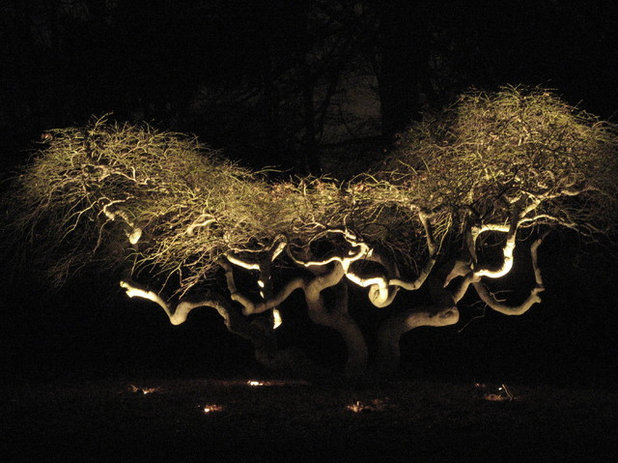
Possidento Lightscapes LLC
Lighting. Your lighting plan should be simple, minimalist and profound. Avoid the temptation to light every feature. Task lighting positioned low alongside pathways makes them safe and functional after dark. Spotlights should focus on water features, sculpture and specimen plants. If in doubt about whether to light something, leave it alone. Remember, there’s a fine line between artistic lighting and the Vegas Strip.
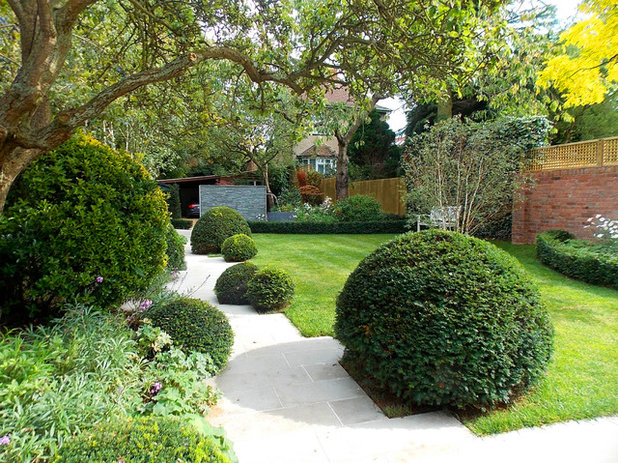 What about the plant selection?
What about the plant selection? Loud and lively colors, while lovely and at home in other areas of the garden, rarely earn a place in the Zen garden. In their absence, the eye instead contemplates shape, texture and placement.
Foliage color is generally varying shades of green, soft blues or darker reds. Strongly variegated foliage may be too abrupt for gardens in this genre. The thoughtful blending of shapes and textures adds interest while peacefully engaging the mind. If you doubt your ability to do this yourself, hiring a good designer can be a worthwhile investment.
In the photo shown here, notice how the varying sizes and similar shapes of the boxwood (
Buxus sp.
, USDA zones 5 to 9; find your zone) pull your eye effortlessly through the space. They form a solid relationship with one another as well as with the path, as they interestingly and unexpectedly cut into it.
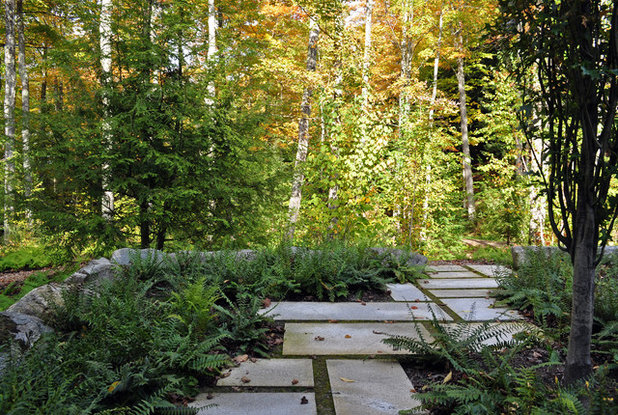
Shepard Butler Landscape Architecture
Take a mental inventory of which plants make you feel tranquil and refreshed. Ferns, such as these native Christmas ferns (
Polystichum acrostichoides, zones 3 to 9), are a great choice for the shade garden. Ornamental grasses, like U.S. native switchgrass (
Panicum virgatum, zones 5 to 9), are a good choice for sunny spots. Their textural foliage rustles in the breeze, adding tranquil movement and sound.
Don’t feel compelled to choose a strict Japanese plant palette. Your Zen garden should include plants that appeal to you and grow well under your conditions.
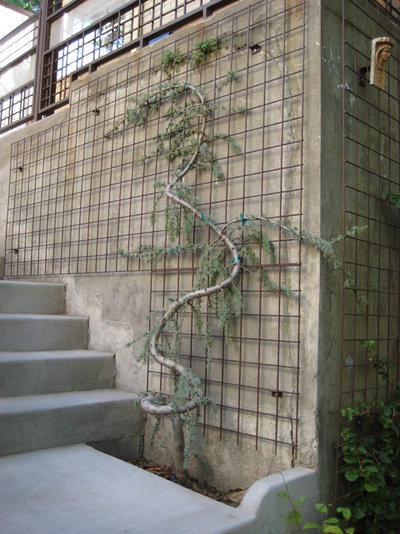
TERRABELLA, inc.
Specimen plants. Properly chosen and sited specimen plants can make a good garden great. Make an effort to choose specimen plants that seem to have personality: a strong and contorted shape, interesting foliage texture or exfoliating bark. Remember that your specimen needs to both stand out and make a connection with its bed mates, as well as any nearby architecture.
Conifers, such as this blue atlas cedar (
Cedrus atlantica ‘Glauca pendula’, zones 6 to 9), and Japanese maples
(Acer palmatum, zones 5 to 8) are natural choices for specimen trees in the Zen garden. Multi-stemmed trees, such as apple serviceberry (
Amelanchier x
grandiflora ‘Autumn Brilliance’, zones 4 to 9), paperbark maple (
Acer griseum, zones 4 to 8), ‘Natchez’ crape myrtle (
Lagerstroemia ‘Natchez’, zones 6 to 9) and various birches are suitable and recommended. Consider placing a boulder near or underneath your tree for an interesting vignette.
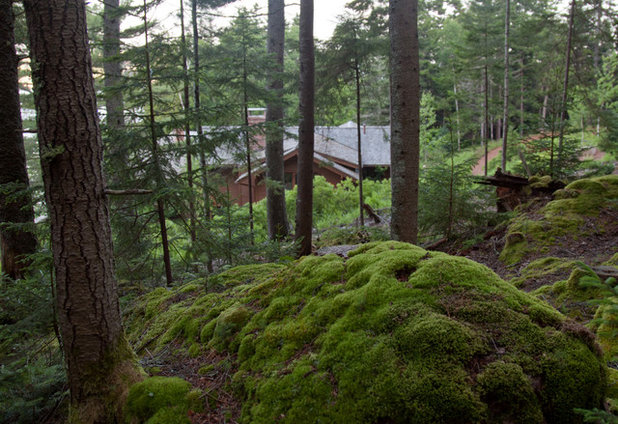
Matthew Cunningham Landscape Design LLC
Moss. There’s no denying the tranquil feeling that comes from moss. Asian gardens have incorporated moss in their designs for hundreds of years. Since moss is native to a large portion of the United States, it’s a perfect choice for your Zen garden if you can give it what it likes. Generally, moss appreciates part sun to shade and moist soil, but certain varieties naturally grow on rocks in ravines and near water.
Moss: Nature’s Carpet for the Garden





